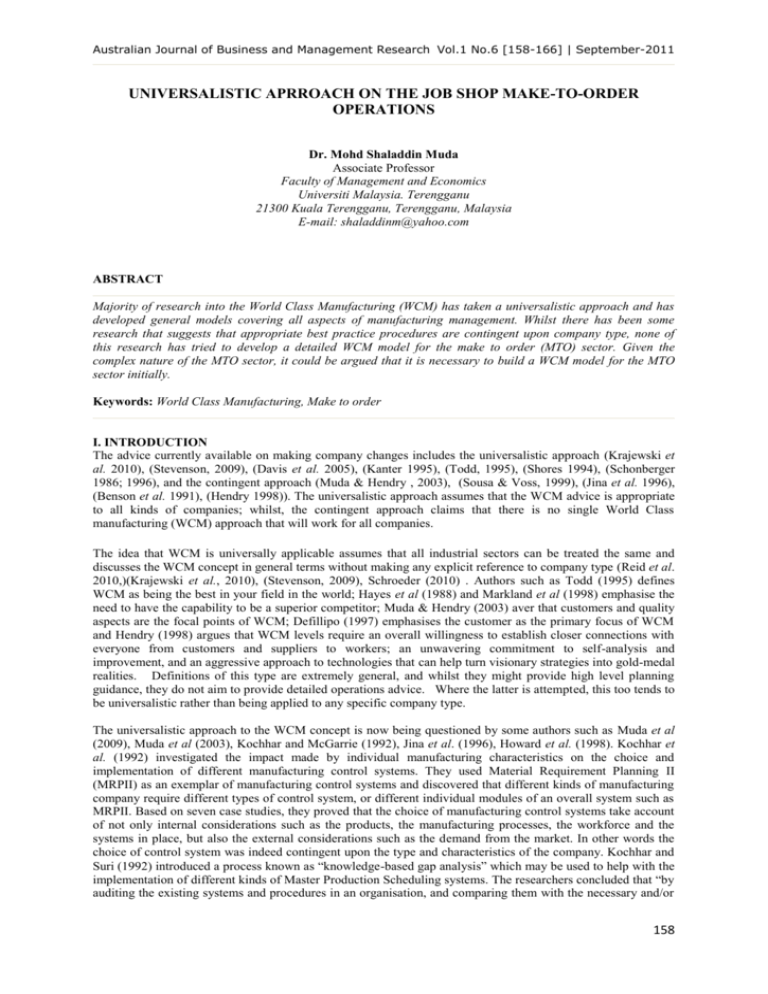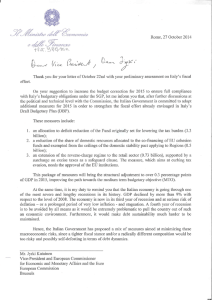world class concept in the job shop make-to
advertisement

Australian Journal of Business and Management Research Vol.1 No.6 [158-166] | September-2011 UNIVERSALISTIC APRROACH ON THE JOB SHOP MAKE-TO-ORDER OPERATIONS Dr. Mohd Shaladdin Muda Associate Professor Faculty of Management and Economics Universiti Malaysia. Terengganu 21300 Kuala Terengganu, Terengganu, Malaysia E-mail: shaladdinm@yahoo.com ABSTRACT Majority of research into the World Class Manufacturing (WCM) has taken a universalistic approach and has developed general models covering all aspects of manufacturing management. Whilst there has been some research that suggests that appropriate best practice procedures are contingent upon company type, none of this research has tried to develop a detailed WCM model for the make to order (MTO) sector. Given the complex nature of the MTO sector, it could be argued that it is necessary to build a WCM model for the MTO sector initially. Keywords: World Class Manufacturing, Make to order I. INTRODUCTION The advice currently available on making company changes includes the universalistic approach (Krajewski et al. 2010), (Stevenson, 2009), (Davis et al. 2005), (Kanter 1995), (Todd, 1995), (Shores 1994), (Schonberger 1986; 1996), and the contingent approach (Muda & Hendry , 2003), (Sousa & Voss, 1999), (Jina et al. 1996), (Benson et al. 1991), (Hendry 1998)). The universalistic approach assumes that the WCM advice is appropriate to all kinds of companies; whilst, the contingent approach claims that there is no single World Class manufacturing (WCM) approach that will work for all companies. The idea that WCM is universally applicable assumes that all industrial sectors can be treated the same and discusses the WCM concept in general terms without making any explicit reference to company type (Reid et al. 2010,)(Krajewski et al., 2010), (Stevenson, 2009), Schroeder (2010) . Authors such as Todd (1995) defines WCM as being the best in your field in the world; Hayes et al (1988) and Markland et al (1998) emphasise the need to have the capability to be a superior competitor; Muda & Hendry (2003) aver that customers and quality aspects are the focal points of WCM; Defillipo (1997) emphasises the customer as the primary focus of WCM and Hendry (1998) argues that WCM levels require an overall willingness to establish closer connections with everyone from customers and suppliers to workers; an unwavering commitment to self-analysis and improvement, and an aggressive approach to technologies that can help turn visionary strategies into gold-medal realities. Definitions of this type are extremely general, and whilst they might provide high level planning guidance, they do not aim to provide detailed operations advice. Where the latter is attempted, this too tends to be universalistic rather than being applied to any specific company type. The universalistic approach to the WCM concept is now being questioned by some authors such as Muda et al (2009), Muda et al (2003), Kochhar and McGarrie (1992), Jina et al. (1996), Howard et al. (1998). Kochhar et al. (1992) investigated the impact made by individual manufacturing characteristics on the choice and implementation of different manufacturing control systems. They used Material Requirement Planning II (MRPII) as an exemplar of manufacturing control systems and discovered that different kinds of manufacturing company require different types of control system, or different individual modules of an overall system such as MRPII. Based on seven case studies, they proved that the choice of manufacturing control systems take account of not only internal considerations such as the products, the manufacturing processes, the workforce and the systems in place, but also the external considerations such as the demand from the market. In other words the choice of control system was indeed contingent upon the type and characteristics of the company. Kochhar and Suri (1992) introduced a process known as “knowledge-based gap analysis” which may be used to help with the implementation of different kinds of Master Production Scheduling systems. The researchers concluded that “by auditing the existing systems and procedures in an organisation, and comparing them with the necessary and/or 158 desirable prerequisites, it is possible to identify the major problems which must be addressed by the management in order to achieve an effective implementation”. Authors such as Jina, Bhattacharya and Walton (1996), explain that lean manufacturing procedures need to be adapted if they are to be applied to companies which they describe as „high variety low volume‟ (HVLV) manufacturers. They concluded their research by examining some of the developments in two very different types of HVLV organisation. One was a very low volume manufacturer in the aerospace industry, and the other was a manufacturer of a low to average volume of specialist machinery. Both organisations have a “high variety, make to order” business strategy. The research shows that the emphasis of the lean manufacturing elements employed depends on the specific circumstances of the HVLV organisation. They claimed that “the lean formula is applicable directly only to a small proportion of manufacturers: most companies must carefully judge which lean practices they can use immediately and which need to be adapted to meet their special circumstances”. The ideas that the choice of control system was contingent upon the characteristics of the company were also sustained by authors such as Muda et al (2009), Muda et al (2003), Howard et al. (1998), Sousa & Voss (1999). For example, Muda et al (2009), Howard et al. (1998) claim that there are many approaches to manufacturing planning and control which have been used (MRP, MRPII, OPT, JIT, etc.); all have particular strengths in particular areas, and no one single method is appropriate for every company. Howard et al. (1998) have developed a model which is claimed to be capable of providing independent objective advice to companies for defining a functional specification for appropriate planning and control systems. Authors such as Sousa & Voss (1999) examined the link between a plant manufacturing strategy and the pattern of use of best practices. Their research was based on three companies, each of a dissimilar company type as characterised by their choice of manufacturing strategy, that were all judged to be mature in their use of best practice paradigms. They used quality management as an exemplar of best practice, and found that the choice of procedure was indeed contingent upon the type of company. Shores (1994) provides a checklist of nine questions for a firm to rate itself whether it is achieving WCM or not. Shores (1994) claims that there is no single approach that will work for everyone. Every business and environment is different, and adjustments need to be made to suit each case. However, the guidance he provides is generic; he only provides one list which firms must adapt for themselves. Muda et al (2009), Muda et al (2003), Hendry (1998) presents a more thorough review of the literature, illustrating areas in which the general advice on becoming world class does not apply to make-to-order (MTO) companies in particular. Hendry (1998) claims that a universalistic approach to WCM practice is not beneficial for firms in the MTO sector. According to Hendry (1998), most of the WCM advice is general and concentrates on methods of operating that have come to be considered as “best practice” in recent years. The paper concludes by making a preliminary attempt to identify a better set of guidelines for this sector. The guidelines are categorised into “small impact” and “big impact” changes. “Big impact” changes include: improve visibility, exploit capacity, set up time reduction, improve information flow and scheduling, and implement a performance measurement system. “Small impact” changes relate to the design issues, commonality of parts (common forgings), improve relations with suppliers and customers. However, the advice given by Hendry is not detailed and the paper concludes that a more refined working model is needed for the MTO sector. Further research is therefore needed to develop and justify the proposed guidelines. II. THE DIFFERENCES BETWEEN MAKE TO STOCK (MTS) AND MAKE TO ORDER (MTO) The make to stock (MTS) operation remains distinct from make to order (MTO) as the products in MTS companies are designed by the companies prior to receiving orders from the customer. They are mostly standard products that can be produced in large quantities and stocked if it is economical to do so. The customers may purchase the products directly from inventory at a retail outlet or at the factory distribution centre. In some cases, products can be modified according to a customer‟s requirement, and therefore, are not produced until an order is placed. Nonetheless there is a large degree of similarity between products. In contrast, the MTO companies manufacture a wider variety of products in relatively low volumes. Products are always manufactured to customer design and specification and, therefore, the production can only start after the customer places an order, as instruction from the customer is required. In cases where a particular company specialises in a type of product, the volumes are low even at the component production stage as the product size and material specifications tend to vary enormously. To win an order, the company has to compete with other companies on the basis of price and the delivery date. Hendry et al. (1993) claim that in some cases, the customer may specify the price he is willing to pay and ask whether the manufacturer can do it and what would 159 be the delivery time, or the customer may specify a delivery time and ask for a price, or ask for both. Table 1 compares some of the characteristics of the two groups, MTO and MTS, as set out by Muda et al. (2003), Hendry et al. (1993), Hill (1993, 1995), and Amaro et al. (1999). Table-1: A comparison of MTO and MTS companies Make-to-order companies Make to stock companies Few standard products Product/family focus Few regular customer Having regular customers Many suppliers Few suppliers Multi-task machinery and flexible workforce Specialist machinery and workforce Volatile and can rarely be predicted Predictable demand Based on receipt of customer orders. Cannot be planned in advance. Production based on forecast demand. Planned well in advance. Adjusted later if necessary Lead time vital for customer satisfaction. Agreed with customer Lead time is unimportant to customer. Can be set internally Prices are negotiated with customers prior production. Prices are fixed by the producer Given these distinct differences, it is clear that companies in the MTO sector will need to use different operations processes than those in the MTS sector. Yet much of the universalistic literature assumes that all companies should adopt practices that apply to MTS. The remaining sections of this paper present the reasons why some of the universalistic approaches are not entirely appropriate for the MTO sector. Firstly, in Section 3, some of the assumptions that occur in several WC model are described and the reasons why these are not entirely appropriate in content and/or emphasis for the MTO sector are explained. Then, Section 4 discusses the important activities and processes in MTO manufacturing that are not addressed in the WCM models. This discussion demonstrates the need for a new model for “World Class Manufacturing” in the MTO sector, which is later explained in the concluding section. III. COMMON ASSUMPTIONS THAT DO NOT APPLY TO MTO The main assumptions that are found in the universalistic model which are inappropriate for the majority of MTO firms can be categorised as follows: Product/ customer families are assumed to exist or be easily identifiable Some of the ideas clearly refer to product/customer families, making the assumption that there is some common ground that can be established between aspects of the production process. These aspects may include having common material requirements, labour skills, tooling, set up procedures and flow or routing, which lead to a similarity in the way the group of products are manufactured. Most importantly, the processes are quite repetitive, even though the products in the family may differ somewhat. However, in the MTO sector, the potential to group products is lower because products are always manufactured to customer design and specification. Even where the company specialises in a type of product, the volumes are low even at the component production stage as the product size and material specifications tend to vary enormously. The level of emphasis in this issue is therefore, too strong to be applicable to the MTO sector in general. Workers can be grouped into teams that focus on specific product or customer families Given that there is less potential to form product/family groups, there is obviously also less potential to form workforce teams on this basis. In some small companies, there may also be the problem of insufficient number of employees that make it not worth for the companies to group them into teams. However, working in a team environment to achieve specific objectives may be possible in the MTO sector. For example, teams could be established around some of the production processes such as drilling, painting, 160 finishing and so on. In some cases, it may also be possible to form a team on a short-term basis for a specific project. Such teams could address issues such as better housekeeping, improving productivity and product quality. Therefore, although some form of team working may be appropriate, any emphasis on product/customer focus teams needs to be removed. The customers are assumed to be fairly constant over time Another assumption is that the customers are fairly constant over time. This idea may be attainable for Repeat Business Customisers but not for Versatile Manufacturing Companies. According to Amaro et al. (1999), MTO companies can be split again by another dimension. This dimension is concerned with whether companies are involved in bidding for one-off orders or for a series of similar orders. “Repeat Business Customisers” (RBC) is used to describe a MTO firm who has to enter a bid once only for a series of similar orders. “Versatile Manufacturing Companies” (VMC) is used to describe companies in the alternative type of market in which, each order is for a one-off product or one-off buying decision. The RBC market “is the one where the competitive tender is to design and produce a product to meet regular and repeated need for a reasonable period into the future” (Amaro et al. (1999)). The competition and customisation are only during an initial customer purchase decision. After that, based on the agreement to supply the contract, the customer will place repeated orders with the same supplier. Generally RBCs are producing a low product variety and have a small number of customers but high volumes per product. In the VMC market, every order is considered as an individual independent buying decision. The customers send every order as an enquiry to a group of potential suppliers regardless of whether it is for a new design of product or a standard product that has been bought before. To win an order, the company has to determine a price and a delivery lead-time to quote as an individual bid in response to each customer enquiry. “Each order generally requires different amounts of processing at its work centres and in a different sequence. These companies have to show versatility in their marketing, production planning, use of resources etc. over time in order to survive” (Amaro et al.(1998)). Normally, VMC companies manufacture high product variety in low volumes. Even for RBC, the company may not be able to establish a very long-term relationship with its customer compared to companies in the MTS sector. Thus RBC companies will still have relatively high variety and low volumes and cannot make as many efficiency gains as MTS companies can with a fairly constant customer, and is, therefore product based. There is a degree of repetition in the work that makes training in “fail-safing”, etc. possible According to Shonberger (1996), “fail-safing means embedding in the process a device or procedure that will never again allow a non-conformity to occur or to go forward. Then whenever problems surface, their response is to form study teams to isolate root causes and fail-safe the process so the problem is stamped out forever”. This idea of being able to stop problems recurring assumes a degree of repetition in the production process. If the same product is being made on a repeat basis, it is much easier to identify problems and prevent them from occuring again. Often, the most significant feature of the MTO manufacturing especially VMCs, is that they are producing a wide variety of new products in low volumes. Since the company keeps producing new products, they will encounter many different kinds of problems during each process. This makes it much more difficult to anticipate and stamp out problems in future orders. However, there is a degree of repetition of using the machine that makes some training in “fail-safing” the machines possible in the MTO sector, although it must be concluded that there is less potential for this type of company to learn from its past mistakes. This degree of repetition also enables MTO company to use a limited number of suppliers, components etc. Given the lack of standard products in the MTO company, it is usually more difficult to reduce the number of suppliers. Jina et al. (1996) suggests that the MTO company can make changes in this area by aiming at “common forging”. However, in many cases, even an attempt for parts commonality or common forging may be extremely difficult given that the customer has such a heavy influence on the design of the products. Zero-defects are attainable due to repeat production Failure to do things right causes many disruptions of material flow through an operation. According to Markland et al. (1998), jobs that must be redone create additional costs through scrap and rework that are usually not recoverable. This is true for all kinds of manufacturing environments including MTO companies. However, the 161 degree to which it is possible to improve quality and reduce waste will vary from one company to company. For example, cutting rework defects and lateness to zero or 1.5 C pk (process capability index) which equates to 3 part defects per million (Maleyeff (1997)), may be difficult in some MTO companies because of the high variety of new products being made. This issue is related to the issue of fail-safing discussed before – again it is the difficulty of learning from past mistakes given that the order book varies constantly that makes this assumption less valid for the MTO sector. A simplified shop floor layout such as the cellular layout can be achieved The term cellular layout is not explicitly used in the literature but underlies some of the WCM principle. For example, Schonberger (1996) claims that a layout of this type is essential if a company is to reduce the flow times, distances and set-up/changeover times by the 90% required to gain the highest score. In cases such as this principle suggested by Schonberger (1996), it can be argued that the MTO firm should also try to reduce flow times, distances and set-ups. However, the methods open to them, that enable the required degree of flexibility to be sustained, are unlikely to lead to such high reductions (Hendry (1998), Jina et al. (1996)). Indeed, shop floor simplification using a cellular layout assumes that cells of product families can be found, which as discussed earlier, is difficult given the high variety of products in most MTO firms. Implementing JIT control systems and principles in MTO The benefit of implementing just-in-time (JIT) principles in a repetitive manufacturing environment is well known (Morton, 1994). JIT is designed to achieve high volume low variety production using minimal inventories of raw material, work in process, and finished goods. However, the environmental conditions in MTO typically require a different kind of control system to manage its operation. Krajewski et al. (2010) claim that the success of a production system depends on the manufacturing environment, not on the system. According to Gargeya et al. (1994): “Job shops have two unique characteristics that may constrain their abilities to accept and implement the JIT philosophy. Small job shops (relative to large manufacturing firms) have a broad product range and meagre operating revenues. As a result, they lack the ability to process jobs in a continuous or repetitive manner and are severely constrained in resources – such as capital, human power, and managerial expertise.” Again, it is the issue of lack of repetition that makes this assumption regarding the use of JIT less appropriate to MTO. In a JIT production system, jobs are pulled through the system, that is they are authorised whenever they are needed (Hurley et al. (1999), Gargeya et al. (1994)). The kanban control system is used to limit the amount of work-in-process (WIP) between production stages. For this to work, a standard set of components are needed, which are manufactured through the same production stages on a repeat basis. This is not the case in a MTO environment in which every job may have a distinctly different routing. Furthermore, the variability in processing times and the inability to allocate tasks to various production stages equally will create imbalance on the shop floor and the kanban system is not designed to deal with such imbalances (Huq and Huq, 1999). For these reasons, “it is recommended that companies should not attempt to implement JIT in job a shop. Instead they should look into the option of implementing better shop control procedures” (Huq and Huq, 1999). Author such as Handfield and Pannesi (1995), attempted to apply JIT methods in MTO manufacturing. However, their work clearly addresses the standardised customisation MTO processes. These companies only produce products based on an existing design. The reason for doing this after receipt of a customer order is that this is cheaper for expensive products for which there is an irregular, low demand. Thus, this application of JIT does not apply to the type of MTO company addressed in this paper. Having said that a JIT control system is unlikely to work, the MTO company may be able to implement some aspects of the JIT philosophy. These aspects may include preventing of crucial idle resources, reducing inventory and queues, improving workers‟ understanding of quality issues and cutting rework. These are valid aims in all manufacturing firms and so it is important to ensure training to make employees aware of these issues. In conclusion, it can be seen that JIT control systems are concerned with high volumes and low variety repetitive production environments. They may also be appropriate for medium volume/variety or fit with the ideas on mass customisation. But as will be shown in the detailed discussion in the following sections, when it comes to the low volume and high variety end of the spectrum as experienced by MTO companies, the ideas that result from these assumptions can often be less workable. 162 IV. ISSUES RELEVANT TO MTO NOT INCLUDED IN THE WC MODEL An important conclusion that can be drawn from the discussion of several universalistic approaches is that many areas that need to be addressed for the MTO sector are not included in WC model. These areas can be listed under six distinct headings as described below. The divide between the marketing and production functions The first issue, the need for integration of the production and marketing functions when bidding for customer orders, has been recognised by many researchers including Henderson (2001), Brown (2000), Hill (1993), Kingsman et al. (1993), Lee and Kim (1993) and Hendry et al.(1993). A major problem in MTO is the divide between sales/ marketing and production. The dilemma is usually caused by dissimilar objectives. The production function is usually evaluated by the costs incurred. Hence, the production is more concerned with costs rather than profits. The marketing division aspires to increase its market share and is often more interested in total sales than profits. If this conflict is to be resolved, it will be necessary for the marketing department to be aware of the capabilities of manufacturing and to take full advantage of them (Hendry and Kingsman, 1993). Likewise, the production function should be conscious of the importance of particular customers and be prepared to adjust its capability in specific events, where feasible. Where co-operation of this type does not exist, orders are often delivered later than promised and/or are produced at a loss rather than generating a profit. The world class MTO firm should have systems in place that ensure that realistic yet competitive prices and delivery dates are quoted for incoming enquiries, and should be able to manage its order book in such way as to ensure future business by maintaining a good reputation for reliability. The nature of the design process, which needs to allow for the quick production of new manufacturing specifications for tenders The second issue, relating to the distinct nature of the design process, has been identified in empirical research carried out by Amaro et al. (1999). These researchers demonstrate that MTO companies should aim to have an efficient and versatile means of developing drawings, designs and specifications for new products. This often entails having a database of products previously produced that can be modified as required. The database should also contain information on parts and forgings that are already used, so that new items are not introduced unnecessarily. As has been described before, it is in the latter area of common forgings that MTO companies often gain the most, as the parts themselves often have to be made in-house to customer specification. The nature of any “repeat” business which can be obtained and the consequent relationships with customers The third issue, regarding “repeat business”, has been identified by Amaro et al.(1999). As explained earlier, some types of MTO producers, referred to as RBCs, usually try to gain repeat business by developing long term relationships with their customers. Where companies are able to gain some repeat business, efficiencies are gained and these enable them to reduce costs and therefore, become more competitive on other orders for which they are bidding. Thus, a characteristic of a world class company would be to have achieved some success in obtaining both repeat business and the consequent efficiency gains. Flexibility of process that often requires a job shop layout The flexibility of process, referred to in this fourth issue, relates to the need for many MTO companies to make a strategic decision to retain a functional layout rather than changing to a cellular one. As discussed by Hendry (1998), some authors, such as Ward (1994) and Jina et al. (1996), suggest that this may be true for a one-of-akind or small batch producers and for companies that manufacture a large proportion of „strangers‟. The option of changing to a cellular layout may still be possible if product families can be identified (Ferras, 1994) and should always be considered. However, it cannot be assumed that this is an essential characteristic for a world class MTO company. Instead, more efficient methods of operating under a job shop setting need to be investigated as will be discussed in the next issue. Methods of controlling the workloads/queues in a job shop environment Several alternative methods of controlling the workload/queues in a job shop, as will be suggested in this fifth issue, have been discussed in the literature. Firstly, there is the concept of order release – that is determining when to release a job from the planning stage to production, which has been discussed by authors such as Melynk and Ragatz (1989); Philipoom et al. (1993); Lingayat et al. (1995); and Bergamaschi et al. (1996). This concept has been incorporated into a body of research, which has been given the label of workload control by authors in the field such as Land and Gaalman (1996, 1998). The aim is to control the total amount of work on the shop floor in such a way that firms can more consistently meet promised delivery dates, an important objective for MTO firms. To implement a full system of this type would require the implementation of 163 computer software that is not yet readily available on the software market and hence „in-house‟ systems would need to be developed. Alternatively, it is possible to consider the use of finite or infinite capacity planning techniques, along with some ideas from the more traditional, larger body of research into alternative job shop scheduling or dispatching rules (for example see Schartner and Pruett (1991)). Material of this type is readily available in software packages such as the FOURMAN software described in a product overview by the producers MAPS (1995). Lastly, case study evidence presented by Hendry (1998) suggests that simply improving the overall tidiness of the shop can have a big impact even in the job shop environment. This could involve simple storage systems for tooling and WIP, that can greatly reduce the amount of non-value added time used in the more typical untidy job shop. The choice of method to be implemented cannot be easily prescribed as has been discussed by authors such as Porter and Little (1996). It depends as much on the availability of appropriate software as on the size/complexity of the business, which will dictate both the cash flow available for software and whether sophisticated software or simpler spreadsheet methods can be implemented. In conclusion, it is argued that the world class MTO company should: have implemented appropriate scheduling systems, making use of computer facilities if appropriate; have seen big reductions in WIP and be able to offer short manufacturing lead times and a reliable service to the customer by a reduction in non value-added time. Pride of craftmanship among the workforce The sixth issue relates to one of the most basic distinctions between MTO and MTS, the inherent flexibility of their workforce. The employment of well-trained, highly skilled employees has been a traditional strength, often described as craftsmanship, in the MTO sector (Hendry (1998)). However, MTO workers often still need to attain higher standards in several areas including motivation, enthusiasm, housekeeping, quality assurance, preventive maintenance, and machine repair. The world class MTO firm will achieve even higher levels of flexibility and worker skill than those levels that can be expected in the MTS firm and therefore, the world class model needs to reflect this. V. CONCLUSION Some of the common assumptions found in the World Class model and other related literature are not appropriate to the job shop MTO manufacturing. For instance, the emphasis on a product family focus, cellular layout, JIT control systems and so on are less relevant to the MTO sector. Therefore, some modifications need to be made to exclude or reduce the emphasis on those inappropriate assumptions and to include the issues relevant to MTO that are missing from much of the WCM literature. The latter include issues on integration between the marketing and production functions, methods of controlling the workloads, the nature of any repeat business and so on. Further research is needed to examine the aplicability of the WCM approach to the MTO firms. If this approach is to be implemented in MTO companies, investigations are required to establish whether new guidance would be essential, or whether the existing WCM approach would meet the needs of the MTO sector. REFERENCES 1. Amaro, G., Hendry, L. & Kingsman, B. (1999). Competitive advantage, customisation and new taxonomy for non make-to-stock companies. International Journal of Operations & Production Management, Vol. 19 (4): 349-71. 2. Benson, G. P., Saraph, J. V. & Schroeder, R. G. (1991) The effects of organisational context on quality management: An empirical investigation. Management Science 37(9): 1107-24. 3. Bergamaschi, D., Cigolini, R., Perona, M. & Portioli, A. (1997). Order review and release strategies in a job shop environment: A review and classification. International Journal of Production Research 35(2): 399-420. 4. Brown S., Lamming R., Bessant J. & Jones P. (2000). Strategic operations management, ButterworthHeinemann: Oxford. 5. Davis M. M. & Heineke, J. (2005). Operations Management: Integrating Manufacturing and Services. New York: McGraw Hill 6. DeFilippo, J.S. (1997). World-class manufacturing in Chengdu: A case study on China‟s first aviation joint venture. International Journal Technology Management 13(5/6): 681-94. 7. Ferras, L. (1994). Continuous improvements in electronics manufacturing. Production and Inventory Management Journal 35 Is. (2):1-5. 164 8. Gargeya, V. B. & Thompson, J. P. (1994). Just-in-time production in small job shops. Industrial Management 36 (4): 23-30. 9. Handfield, R.B & Pannesi, R.T. (1995). Antecedents of leadtime competitiveness in make-to-order manufacturing firms. International Journal of Production Research 33(2):511-37. 10. Hayes, R.H., Wheelwright, S.C. & Clark, K.B. (1988). Dynamic manufacturing. creating the learning organisation, New York: The Free Press. 11. Heizer, J., Render, B. (2010). Operations Management, 10th Edition. USA: Prentice Hall 12. Hendry, L.C. (1998). Applying world class manufacturing to make-to-order companies: Problems and solutions. International Journal of Operations and Production Management 18 (11) 1086-100. 13. Hendry, L.C., Wilson E., Kingsman B.G., Worden L. & Mercer A. (1993) Integrating Heim, J. A. & Compton, W. D. 1992. Manufacturing systems: foundations of world-class practice, Washington D. C.: National Academy Press. 14. Hendry, L.C., Wilson, E., Kingsman, B.G., Worden, L. & Mercer, A. (1993). Integrating production planning in make-to-order companies. Proceedings of the International Conference on Managing Integrated Manufacturing, Keele, UK: 427-436. 15. Hill, T. (1993). Manufacturing Strategy: The Strategic Management of the Manufacturing Function, Basingstoke: Macmillan. 16. Hill, T. (1995). Manufacturing Strategy, Basingstoke: Macmillan. 17. Howard, A., Kochhar, A. & Dilworth, J. (1998). An objective approach for generating the functional specification of manufacturing planning and control system. International Journal of Operations & Production Management 18 (8): 710-26. 18. Huq, Z. & Huq, F. (1994). Embedding JIT in MRP: The case of job shops. Journal of Manufacturing Systems 13(3): 153 –64. 19. Hurley, S. F. & Whybark, D. C. (1999). Comparing JIT approaches in a manufacturing cell. Production and Inventory Management Journal 40, Is (2): 32-37. 20. Jina, J., Bhattacharya, A. and Walton, A. (1996). Applying lean principles for high product variety and low volumes: Some issues and propositions. Logistics Information Management 10(1): 5-13. 21. Kingsman, B.G, Hendry, L.C., Wilson, E., Worden, L. & Mercer, A. (1993). Integrating marketing and production planning in make-to-order companies. International Journal of Production Economics 30-31: 53-56. 22. Kochhar, A., & McGarrie, B. (1992). Identification of the requirements of manufacturing control systems: A key characteristics approach. Integrated Manufacturing Systems 3(4): 4-15. 23. Krajewsky L. J., Ritzman L. P., Malhotra M. K (2010). Operations Management, 9th Edition. USA: Prentice Hall 24. Land, M. & Gaalman, G. (1996). Workload control concepts in job shops: a critical assessment. International Journal of Production Economics 46-7: 534-548. 25. Land, M. & Gaalman, G. (1998). The performance of workload control concepts in job shops: improving the release method. International Journal of Production Economics 56-7: 347-364. 26. Lee, W.J. & Kim, D. (1993). “Optimal and heuristic decision strategies for integrated production and marketing planning. Decision Sciences 24 Is. (6): 1203-13. 27. Lingayat, S., Mittenthal, J., & O Keefe, R.M.(1995). Order release in automated manufacturing systems. Decision Sciences 26 Is. (2): 175-207. 28. Malayeff, J. (1997). Proper use of capability indices. Machine Design 69, Iss.(6): 73-78. 29. Manufacturing Products & Services Ltd. (MAPS) (1995). FOURMAN Product Overview, West Yorkshire. 30. Markland, R. E., Vickery, S. K. & Davis, R. A. (1998). Operations Management, USA: South-western College Publishing. 31. Melynk, S.A. & Ragatz, G.L. (1989). Order review/release: Research issues and perspectives. International Journal of Production Research 27(7): 1081-96. 32. Morton, C. (1994). Becoming world class. UK: Macmillan Press. 33. Muda, S. & Hendry, L.C. (2003). The SHEN model for MTO SME‟s: a performance improvement tool. International Journal of Operations and Production Management 23(5): 470-486, UK:MCB. 34. Muda, S., Wan Abdul Aziz Wan Mohd Amin, (2009), A review on the Classification of the Make-ToOrder Manufacturing Companies, Journal of International Management Studies, Vol 4(2) : 140-146 35. Philipoom, P.R., Malhotra M.K., & Jensen, J.B. (1993). An evaluation of capacity sensitive order review and release procedures in job shops,” Decision Sciences 24(6): 1109-33. 36. Porter K. and Little D. (1996), “Finite Scheduling and MRP– Revealing relationships”, Control, Vol. 22 No. 4, pp. 23-26. 37. Reid, R, Sanders, N. R. (2009). Operations Management, 4th Edition. USA: John Wiley and Sons, Inc. 165 38. Schartner, A. & Pruett, J. M. (1991). Interactive job shop scheduling: An experiment. Decision Sciences. 22 (5): 1024-46. 39. Schonberger, R.J. (1986). World class manufacturing: The lessons of simplicity applied. New York: The Free Press. 40. Schonberger, R.J. (1996). World class manufacturing: The next decade. New York: The Free Press. 41. Schroeder R.G. (2010). Operations Management: Contemporary Concepts and Case. USA: Irwin Professional Pub 42. Shores, R. A. (1994). Reengineering the factory: A primer for world class manufacturing. Milwaukee, Wisconsin: ASQC Quality Press. 43. Sousa, R. & Voss, C.A. (1999). Linking manufacturing strategy and best practice: An empirical investigation of quality management. Proceedings from Managing Operations Networks EurOMA Conference, Venice, Italy. 44. Stevenson, W.J, (2009). Operations Management, 10/e. New York: McGraw- Hill Irwin 45. Todd, J. (1995). World class manufacturing. UK: McGraw Hill International. 166





